Four years ago, nuCamp RV rocked the truck camper marketplace with the Alde hydronic heating system for Cirrus truck campers. In a long-term test, Truck Camper Magazine reviews the system and asks the big question; is the Alde better than a traditional RV furnace and water heater?

*Click here to read nuCamp and Alde’s response to the following review, including comments about camping with the Alde 3010 system in altitudes over 5,000 feet.
I would love to tell you that we planned the following Alde (pronounced all-Dee) hydronic system review months in advance, but that’s not exactly how this went down. In truth, a number of our 2018 priorities – including this review – flew out the window (and all over the Oregon pavement) after last July’s encounter with a certain Toyota Camry.
By the time we reached the Elkhart Open House in September, our project camper was showing more and more signs of accident-related damage; cracks in the walls, separating cabinetry, and a softening floor. Our camper was literally coming apart right before our eyes.
Realizing that our beloved project camper would not last the winter, we made a tough decision. We delivered it to a company that specializes in major RV repairs and restoration. In the end, it would be less expensive to have the camper repaired than purchase a new one. Plus, we love our camper and everything we’ve done to it over the past four years. It’s our home and magazine HQ – on wheels.
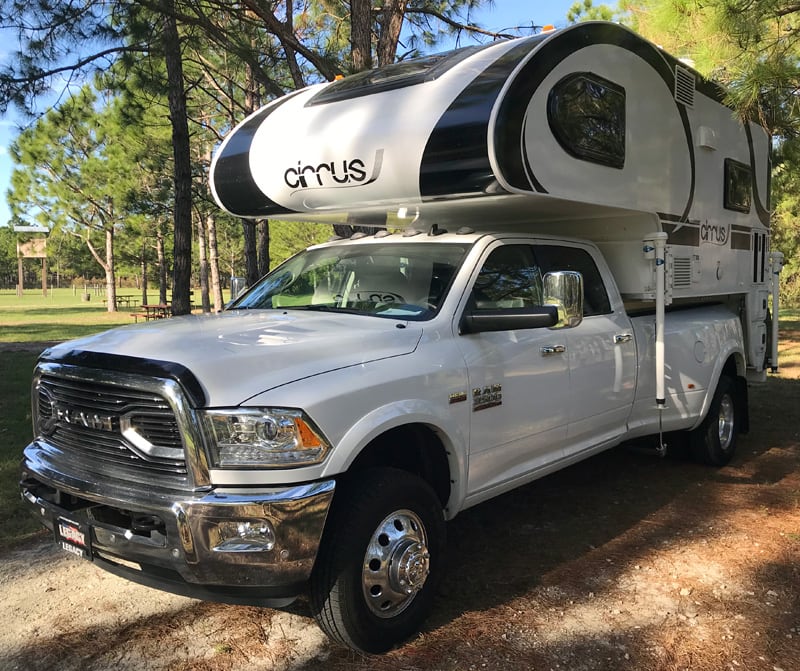
We have been extremely fortunate to borrow and camp long-term in just about every truck camper brand in the United States and Canada – with one glaring exception.
In our 2018 Cirrus 920 Review, I stated:
“While we have spent days at the nuCamp factory on the Cirrus production line, and been through multiple Cirrus 800, 820, and 920 units, we have not actually camped in a Cirrus truck camper. With that experience we would learn about the day to day realities of the Froli system, Alde system, and other unique design, material, and component choices of the Cirrus truck camper line. This is a priority for 2018.”
Enter Toyota Camry stage left. With our damaged camper in the hands of the repair shop, we turned to nuCamp for the loan of a Cirrus 920. They graciously agreed, and supplied us with a unit less than 500-feet from our Elkhart Open House campsite. The timing and opportunity were almost too good to be true. Even better, we would finally get the chance to experience a Cirrus and its unique systems.
First up, the Alde hydronic heating system.
Alde may be a relatively new name in the United States and Canada, but the Swedish company has been in business for over 68-years. Founded by Alde Rask in 1949, Alde Corporation manufactures approximately 23,000 hydronic heating systems per year for travel trailers, fifth wheels, motorhomes, and truck campers across the globe. According to Alde, most of the leading European trailer and motorhome manufacturers use their hydronic heating systems as standard or optional equipment.
The Alde system is based on the concept of hydronic heating. If you’ve ever lived in a house with radiators, you have lived with hydronic heat. A hydronic heating system consists of a boiler and pump that circulates hot water via dedicated plumbing to a series of radiators that emit heat throughout a home.
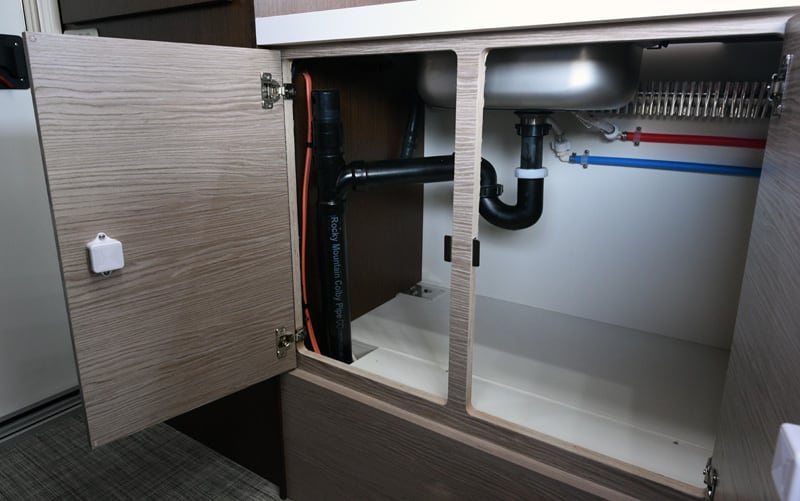
Above: An Alde convector (top right) behind the Cirrus 920 kitchen sink
The Alde 3010 in the Cirrus 920 works on the same concept, with a decidedly modern twist. The Alde 3010 boiler heats about a gallon of propylene glycol antifreeze which in turn heats 2.2 gallons of hot water and then runs through a series of metal-finned convectors (radiators). The Alde convectors are located behind the walls and cabinetry in the wet bath, kitchen, dinette and cabover to evenly heat the unit.
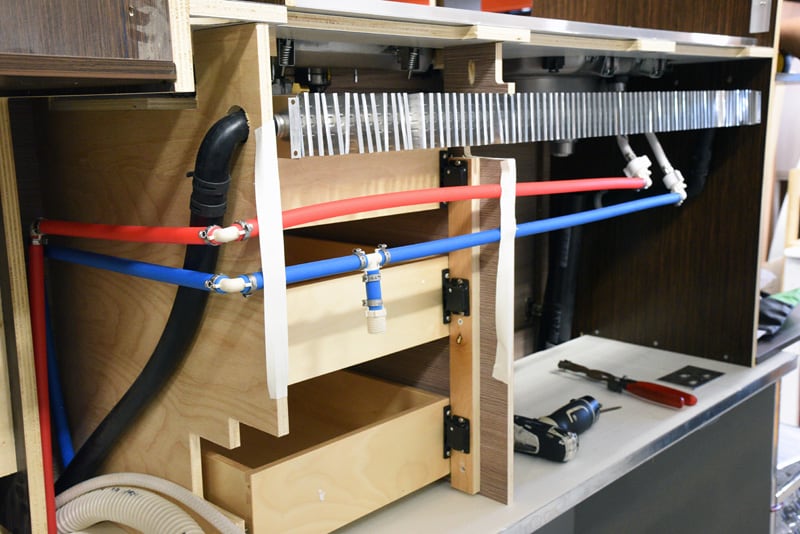
Above: Metal-finned convectors being installed at the nuCamp/Cirrus factory
The stated advantages of the Alde hydronic system are that it’s clean (no forced air blowing dirt and dust), quiet (no furnace fan to wake you up), and comfortable (even heat).
Alde also claims that the system is more efficient than traditional RV water heaters and furnaces. The following review puts the, “clean, quiet, and comfortable” claim to the test, and probes the question of efficiency.
The first time we activated the Alde Compact 3010 system on our own was quite disconcerting. We were off-grid and started the Alde in propane mode. Where clicking on a thermostat for a traditional RV furnace almost immediately starts a fan blowing, the Alde seemingly did nothing. No sound. No heat. Nothing.
It was forecast that evening to be in the low 40s. That’s comfortable truck camping weather, but we would typically leave the thermostat at its lowest setting overnight, and then take off the morning chill with a 10-minute furnace blast. We are spoiled.
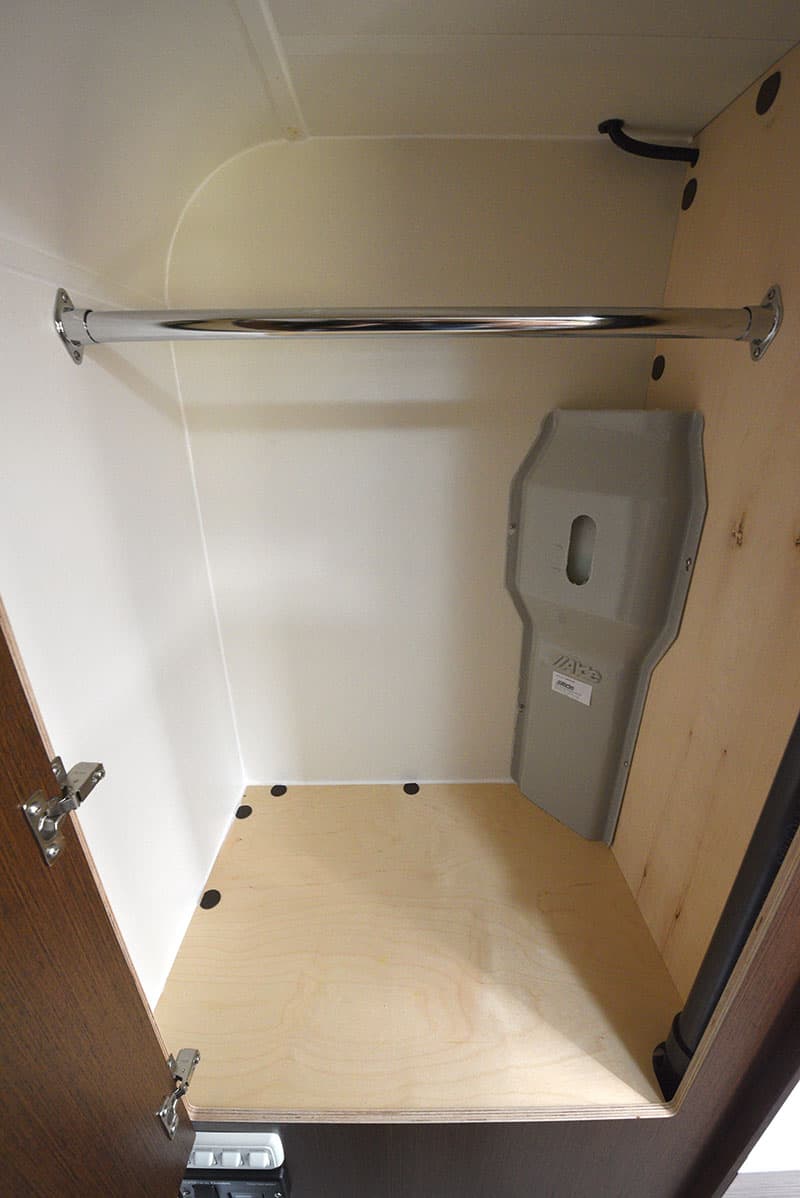
Above: The Alde ethylene glycol reservoir in the Cirrus 920 closet
About a half-hour after activating the Alde system, we heard gurgling noises from the glycol reservoir located in the driver’s side rear closet. The bubbling liquid sounds would be familiar to anyone who has used a portable oil heater.
The sound was an exciting sign of life. The Alde system was on and doing something. The nuCamp team warned us that the Alde system needed about four hours to fully heat a unit, so we needed to be patient.
“There’s heat coming from behind the hamper!”
An hour later, Angela was thrilled when she discovered warm air emanating from vents in the driver’s side cabover hamper. Heat was also rising from the vent behind the passenger’s side hamper, and the camper was starting to feel less cool. It wasn’t heating up like a camper does with a traditional furnace system, but something was happening.
That night we marveled as more and more heat emerged throughout the camper. Other than the occasional gurgling, the Alde system was completely silent. It’s as if the heat was just happening all around us. After 13-years of only knowing furnace heat in truck campers, it was a surreal experience.
In the moments before we went to bed, I asked Angela, “What did you set the Alde system at?”
“I think I maxed it out. It is going to be cold tonight.”
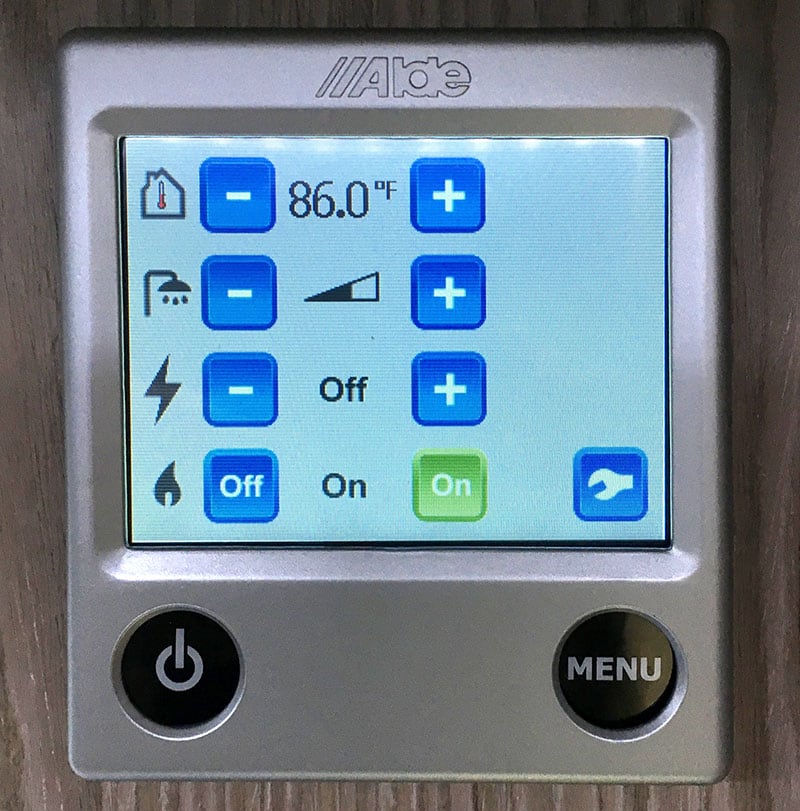
Above: The Alde control panel on its highest temperature setting
By that point the camper was starting to turn into a sauna. Angela had set the system to 86-degrees and it was following her instructions with vigor. At the Alde control panel I turned the temperature down to 69, and went to bed. I won’t tell you what I wore to sleep that night, but it wasn’t much.
The next morning I woke up and thought, “Oh no, the Alde isn’t working!” It wasn’t cold in the camper, but it wasn’t super warm either. We were both very comfortable. Perhaps it didn’t get as cold outside as they had forecast.
Opening the rear entry door instantly dashed that thought. As predicted, it was brisk. The trusty iPhone Weather app said 39-degrees, and it felt at least that cold. No, it wasn’t below freezing, but it wasn’t shorts and T-shirt weather either.
And that’s when it hit me. We didn’t feel like we were in a heated camper. We just felt comfortable. The air was still and at room temperature. It was like being in a house with radiator heat. The walls, floor, and cabinetry of the camper were all at that same room temperature.
The temperature was stable. The air wasn’t oscillating between warm and cold like a thermostat-controlled furnace system does. It was just comfortable. Wow.
From that point on we hardly touched the Alde control panel. Depending on the day, we set it between 68 and 72 degrees. During our travels and camping on the East Coast, temperatures dipped at night into the mid-30s, but the Alde temperature in the Cirrus stayed constant.
About 10-days after taking possession of the Cirrus we stopped by fellow campers John and MaryLou Wells’ home in central Pennsylvania. John is naturally curious about anything mechanical and was interested in how the Alde system worked.
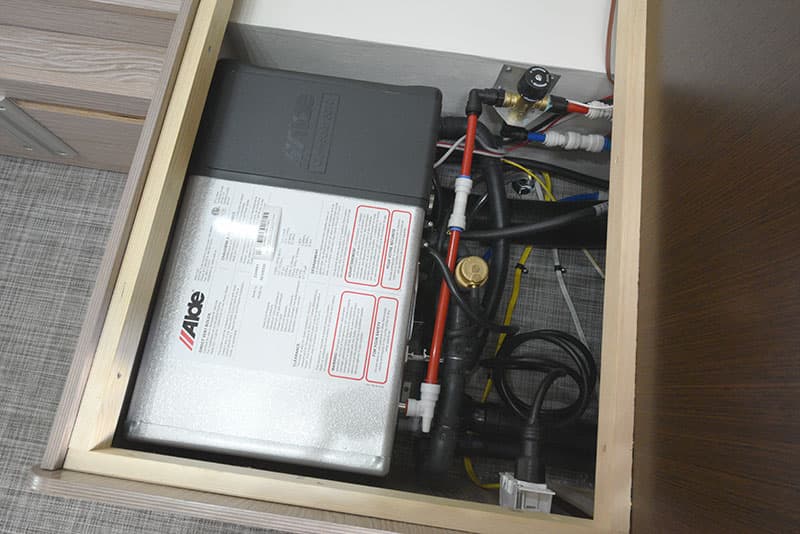
Above: The Alde Compact 3010 boiler unit located under the forward-facing dinette seat in a Cirrus 920
When we showed John the Alde Compact 3010 boiler unit, we told him about the gurgling noises. He suggested the gurgling was likely a sign that the Alde lines needed to be bled, just like a radiator system in a house.
Twenty minutes on YouTube revealed the answer. A rather colorful individual in Europe recommended turning the dial on the Alde inline pump to a lower setting. This would bleed the unit, and silence the gurgling. His recommendation worked like a charm.
We arrived at my father’s house near Philadelphia a few days later, plugged the Cirrus into 30-amp shore power and switched the Alde system from propane to electric. The silent continuous heat continued. Angela was practically jubilant every time we walked in from the cold. The warm Cirrus was heavenly.
Sleeping at night was particularly fantastic as the temperature stayed constant all night long and the Alde heating system remained silent. In our project camper it’s not unusual to wake up several times a night when the furnace kicks on. With the Alde system, only Harley, our intrepid cat, stirred our precious slumber. It’s amazing how much of a difference the hydronic technology makes.
Everything we’ve said so far is about how the Alde 3010 system performs as a heating unit. In two words, it’s awesome. In three words, it’s totally unbelievable. Angela has said one too many times, “How do we get this Alde system in our project camper?” Answer; not easily.
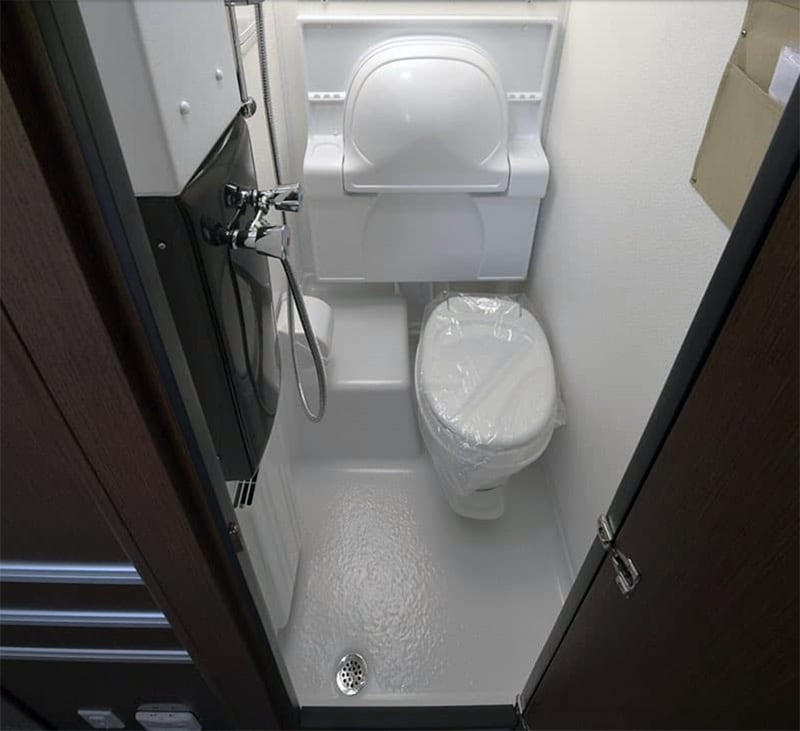
Above: The lower half of the wet bath in the Cirrus 920. Note the fold-up sink and the covered Alde convector towards the floor on the left
Of course the Alde system is not just a heater, but also a 2.2-gallon water heater. The heater works on both electric and propane and has two levels. The level one heats the water to 122-degrees Fahrenheit. Level two heats the water to 149-degrees Fahrenheit. At the higher temperature, more cold water is required to meet the same desired shower temperature.
On level one, the 2.2-gallon water heater lasts long enough for two navy showers. Alde claims that the 2.2-gallon water heater mixes with cold water for approximately 4-gallons of shower water. So far we have not needed to set the Alde at level two. If you take longer showers in your camper, you may need level two. For us, level one has been sufficient.
In our project camper we carry a portable 750-watt ceramic heater. A ceramic heater is great when we’re plugged into shower power and keeps our main living area warm.
We still need to heat the basement now and then with the propane furnace, but a portable ceramic heater is otherwise one of the few must-own items we recommend to all truck camper owners – unless you have a Cirrus.
The Alde hydronic heating system in the Cirrus also works on 110-volt electric. In fact, that same Alde everywhere and consistent warmth works just as well on 110-volt electric as propane. No ceramic heater needed, and it keeps the basement (and everything else in the camper) toasty warm.
I want to make sure you understand the significance of this. No other truck camper (or non-Alde motorhome or towable that we know of) can plug into shore power and have built-in 100-percent electric heat. Built-in electric hot water, yes. Built-in electric heat, no.
Being able to just switch from propane to electric has always been a big benefit of a two-way refrigerators. Now the Alde system adds this feature to the heating system. Love it.
The majority of truck campers on the market use either a Suburban or Atwood/Dometic furnace with 20,000 to 30,000 BTUs. There are exceptions, but this is the BTU range for most truck campers.
During operation, the amp draw of Suburban 20,000 and 30,000 BTU furnaces is 6.5 and 8.5-amps respectively. The amp draw of Atwood/Dometic 20,000 and 30,000 BTU furnaces is 4.8 and 7.5-amps, respectively.
The majority of truck campers on the market use either a Suburban or Atwood/Dometic water heater with either 4-gallons or 6-gallons of water capacity.
The Suburban water heaters range from 9,000 BTU (4-gallons) to 12,000 BTUs (6-gallons) and draw 13-amps. The Atwood/Dometic water heaters range from 8,800 and 10,000 BTU (6-gallon) and draw 12.7-amps.
We were unable to find data on the propane consumption for Suburban or Atwood/Dometic furnaces or water heaters.
The Alde 3010 can be configured to either 11,000 or 18,700 BTU. For both heat and hot water, the Alde system draws a maximum of 1.9 amps for about three seconds when starting on 12-volt DC.
After those three seconds, there are two Alde components that cycle on and off depending on the temperature of the glycol; a combustion fan (0.4 amps), and a circulation pump (0.2 amps). The Alde fan and pump only run when the glycol needs to be heated.
Adding the draw of the combustion fan and circulation pump together, the Alde system draws about 0.6-amps of 12-volt power when running off propane. This explains why the Cirrus 920’s batteries only drop a tenth of an amp or two overnight. You read that right.
When running, the Alde system consumes 0.9 pounds of propane per hour. Alde reports that the 3010 system can operate for two weeks on a 20-pound propane tank. This mirrors our experience as well.
Based on the data and our first-hand truck camping observation, the Alde offers game-changing 12-volt and propane efficiency.
We have two lingering questions about the Alde system; long-term reliability, and on-the-road serviceability. How will the Alde system hold up after years of camping, travel, and storage? And how easy will it be to get parts and service for the Alde system? We have all heard stories about European cars that were lovely to drive, but horrible to maintain. None of us need that.
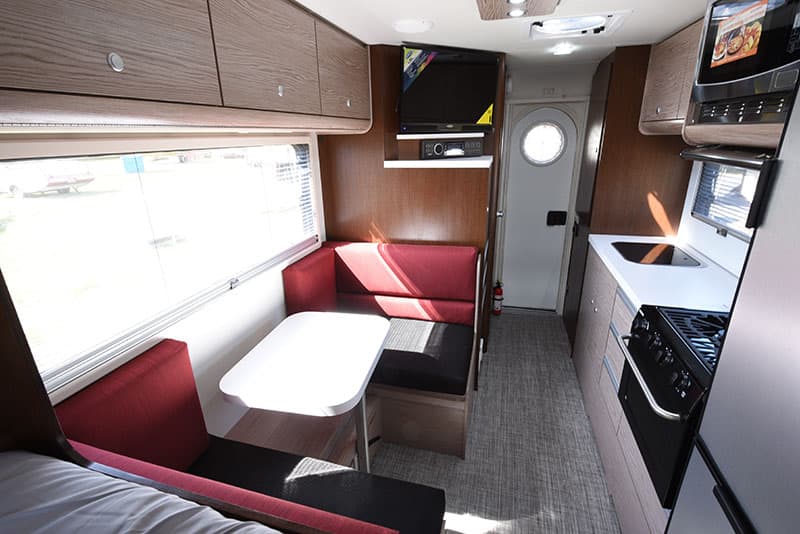
Above: The interior living area of a Cirrus 920
We know about a dozen or so Cirrus owners who have spoken highly about their Cirrus campers, including the Alde system. That’s good, but it doesn’t answer the question of long-term reliability and service.
For that we will have to wait. nuCamp’s Cirrus truck camper line debuted in mid-2015, just three-and-a-half years prior to this writing. That’s obviously not enough time to see how the Alde system holds up five and ten years later.
For additional feedback we can look to other RV manufacturers that install the Alde system including Roadtrek (Class B motorhomes), Airstream (travel trailers), and Erwin Hymer Group (Class B motorhomes and travel trailers). It’s unlikely that these premium RV brands would employ the Alde system if it had significant warranty issues.
In theory, nuCamp, Roadtrek, Airstream, and Erwin Hymer Group are also training their techs on the Alde system and importing the necessary Alde parts for service.
Alde has developed a free smartphone app that finds the nearest Alde service location, contains the manuals, and answers frequently asked questions.
I can hear you saying, “Yeah, but what about the maintenance and repair costs?” Based on the European origin of Alde, we can safely assume the parts will be more than US-made systems, but that could be counter-balanced by the quality of the system, and its efficiency. Only time will tell.
There are pros and cons to every feature and option you add to a truck camper. For example, slide-outs give a camper more interior space, but they add a significant amount of weight and possible maintenance issues. Trade offs in truck campers are everywhere.
The Alde hydronic system is no different. From our experience so far, the Alde is indeed cleaner, quieter, and more comfortable than a traditional RV furnace and water heater. However, the required boiler, convectors, glycol reservoir and plumbing take up a considerable amount of storage throughout the unit.
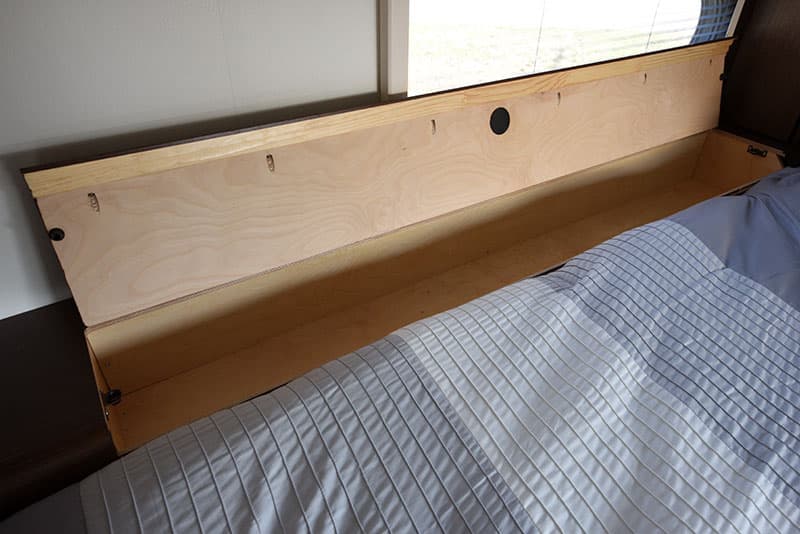
The two hampers in the Cirrus 920 cabover are very long, but also quite narrow. The hampers are narrow because the Alde convectors run behind them. The space necessary for the convectors consumes about 25-percent of the possible hamper space. That’s 25-percent less space to store our clothing, but that clothing is nice and warm! Who doesn’t like toasty underpants in the morning?
Our cat, Harley, found a very different problem. To allow the Alde convector heat to escape from behind the lower kitchen cabinets, the cabinets have slots where they meet the floor. Harley isn’t the neatest of eaters and has flung a few pieces of cat food under these slots.
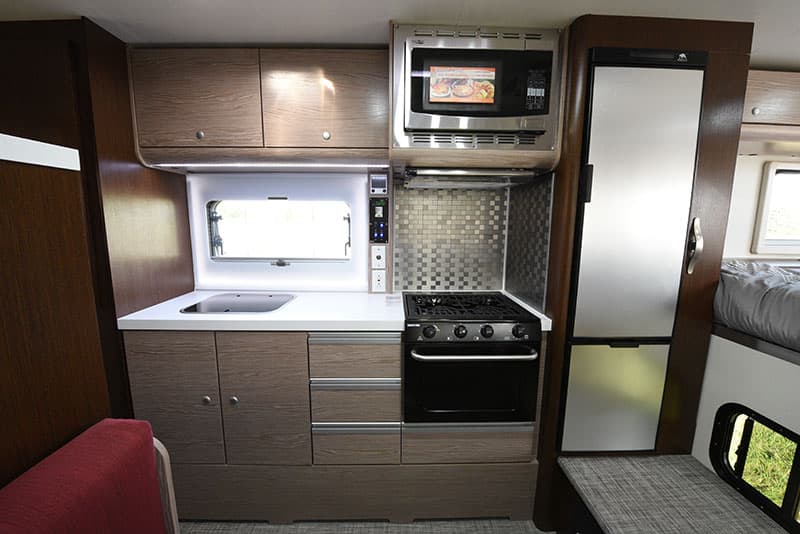
Dirt and other items could potentially get under the cabinetry making for difficult cleaning or retrieval (note the slots under the cabinetry where it’s met by the floor). What if a wedding ring rolled under there? There may be a way to access this area, but we haven’t discovered it yet.
Some folks may be put off by the approximately four-hour wait before a camper is fully heated. We don’t see this as a negative because, once the camper is heated, it stays heated. As I like to joke, it’s warm “Alde time”. Angela hasn’t heard that one enough, so I make that joke… wait for it… Alde time!
Other things are just learning the system and routine maintenance. For starters, nuCamp warned us that you can blow the fuse on the Alde system if you unplug the camper when the Alde system is on electric. In other words, you need to turn off the Alde system before you disconnect from shore power. nuCamp gave us extra fuses just in case we forgot. We actually did a couple of times, but haven’t blown a fuse – yet.
Alde recommends checking the glycol level at least twice a year. The reservoir is in the rear coat closet and the level is relatively easy to read. If it’s low, add more.
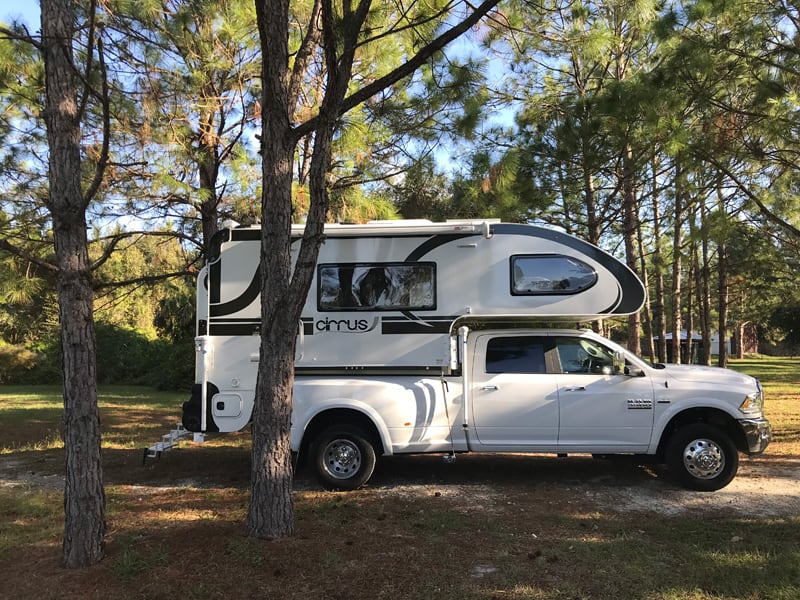
Looking at the manual, winterizing looks like a straight-forward process. We cannot verify the ease of this process as we have not yet needed to winterize.
Besides, the Alde system is designed to automatically dump its fresh water if the water temperature in the unit gets to 38-degrees. This system is truly light-years ahead of standard RV furnaces and water heaters.
We have absolutely loved our time with the Alde 3010 hydronic radiant heating system in the Cirrus 920. You just can’t underestimate how wonderful it is to be consistently warm and comfortable. And it’s silent! And it’s battery and propane efficient! Going back to wake-up loud, overnight battery-draining, hot and cold seesawing, forced air furnace heat is not something we are looking forward to.
The jury on long-term reliability and service must remain out. In the United States and Canada the Alde system just hasn’t been installed in enough RVs for a long enough period of time. And nuCamp is the only company installing the Alde in the off-road and off-grid world of truck camping; shake, rattle, and roll. From our personal experience and conversations with Cirrus owners, we have no reason to doubt that the Alde system will prove itself to be extremely reliable, but it’s too early to call.
If all this sounds like a mixed review, it isn’t. If it were possible, we would snap our fingers and put an Alde hydronic system in our project camper right now. We love it!
Pros
Even and comfortable heat – a real game changer
Completely silent – no wake-up furnace fan
Electric heat on 110-volt shore power
Incredibly efficient 12-volt and propane use
Free Alde smartphone app shows service centers, manual, and FAQ
Alde has 68-year history in Europe with 23K/year install base
Cons
Long-term serviceability in US and Canada not yet established
System needs to be bled occasionally to avoid gurgling
System requires 4-hours to heat – but then stays warm
Boiler, convectors, and plumbing take up potential storage
Small 2.2-gallon water heater – but heats hotter for more water mix
Dirt and stuff could get into slots for convectors
Model Information:
2018 Cirrus 920 (with Alde 3010)
MSRP: $39,533 (for the entire Cirrus 920)
Warranty: One Year Warranty
NuCamp Recreational Vehicles
Phone: 330-852-4811
Request a Cirrus Brochure
Web: nucamprv.com/cirrus
Quality, Customer Service, and Long-Term Reliability
Truck Camper Magazine inspects all reviewed truck campers for design, material, and quality issues and reports what we find. However, since Truck Camper Magazine reviews only brand new truck campers, our reviews do not address long-term quality, customer service, or reliability.
To learn about a brand’s long-term quality, customer service, and reliability, Truck Camper Magazine recommends talking directly with truck camper owners at truck camper rallies and online via truck camper forums and truck camper owners groups.
Please be sure to balance your gathered feedback across multiple sources including direct correspondence with the truck camper manufacturers and your closest truck camper dealers. If you are new to truck campers, please start in the Newbie Corner.
